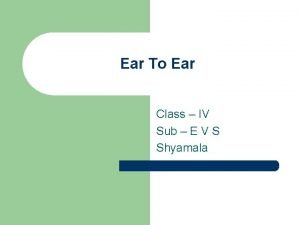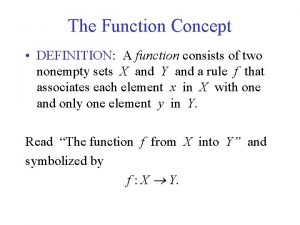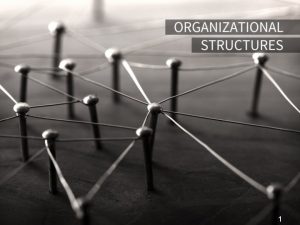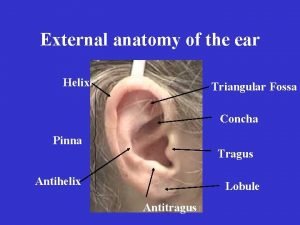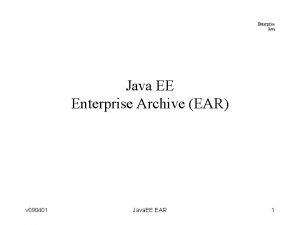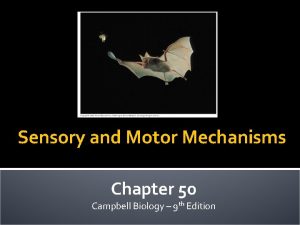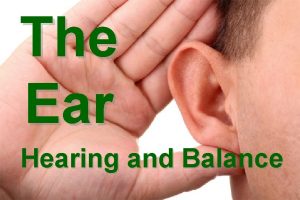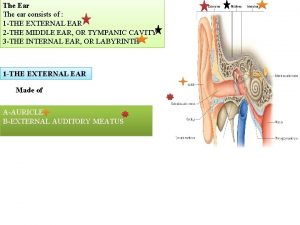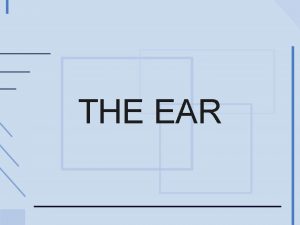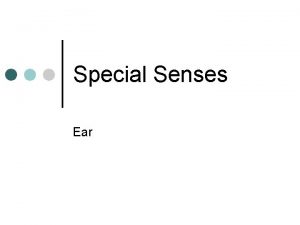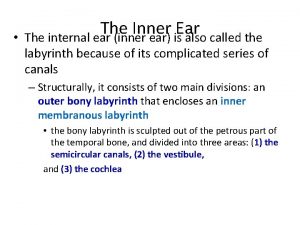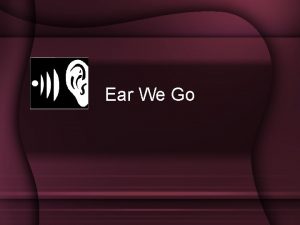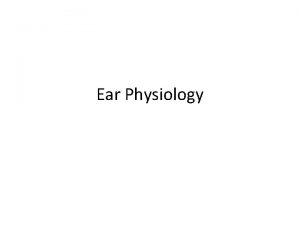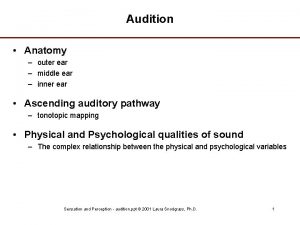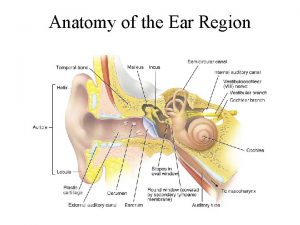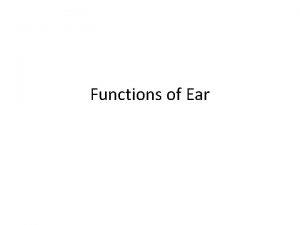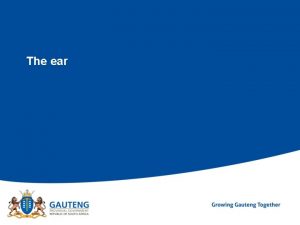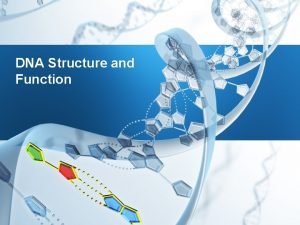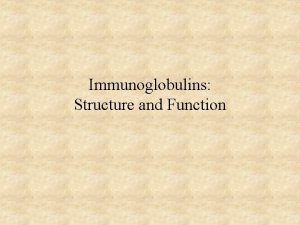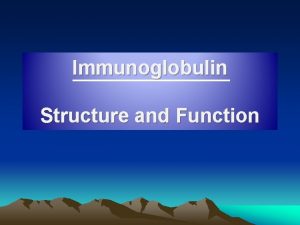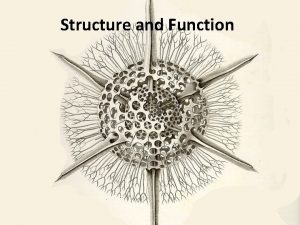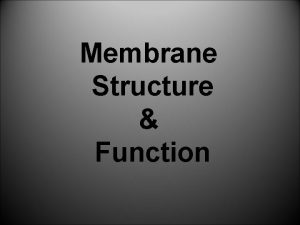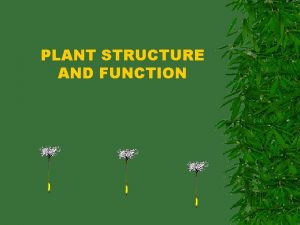Ear Structure and function The ear consists of






























- Slides: 30

Ear


Structure and function • The ear consists of three regions: – Outer ear – Middle ear – Inner ear


Outer ear • Consists of the cartilaginous pinna and an auditory canal Pinna Auditory

Functions of the outer ear • The pinna directs sound waves through the auditory canal to the tympanic membrane • The auditory canal directs sound waves to the tympanic membrane. Cerumen(wax) and hairs in the auditory canal prevents small organisms from entering the ear. Wax also prevents the ear drum from drying out.

Middle ear • Is an air filled cavity within the skull. • It is separated from the outer ear by the tympanic membrane • It is separated from the inner ear by the oval window and the round window Tympanic membrane

Structure of the middle ear

Middel ear cont… • Within the inner ear there are three small bones (ossicles) i. e. hammer (malleus), anvil (incus), and the stirrup (stapes). • The hammer is attached to the oval window; the anvil lies between the hammer and the stirrup • The middle ear is connected to the pharynx by the Eustachean tube.

Functions of the middle ear • Tympanic membrane transmits vibrations to the ossicles • The ossicles transmits impulses from the tympanic membrane to the inner ear • The Eustachean tube maintains equal pressure on either side of the tympanic membrane • The oval window transmits vibrations of the ossicles into the inner ear. • The round window absorbs the pressure set up in the inner ear.

Inner ear • Is a fluid filled cavity made up of the bony labyrinth and a membranous labyrinth • The bony labyrinth has three parts: • Semicircular canals • Vestibule (sacculus and utriculus) membranous labyrinth • Cochlea • Bony labyrinth is filles with perilymph • Membraneous labyrinth is filled with endolymph


Structure of the inner ear Vestibular nerve Semicircular canals Cochlear nerve Oval window Cochlea Round window

Functions of the inner ear • The semicircular canals, sacculus and utriculus are connected with balance and equilibrium. • The cochlea ccontains the organ of Corti which converts the stimulus of sound into impulses • The auditory nerve transmits sound impulses to the brain.

Functioning of the ear • Main functions: – Hearing – balance

Hearing Path of sound • Pinna ------auditory canal ------tympanic membrane ----hammer --anvil ---- stirrup ---- oval window---perilymph---organ of Corti---auditory canal ----brain

Balance • Sudden changes in speed and direction causes the endolymph within the semicircular canals to move. • The movement of the fluid stimulates the cristae in the ampullae – situated at the base of the semi circular canal. • When the direction of the head changes, gravitational pull stimulates maculae – in the sacculus and utriculus • Within the cristae and maculae the stimuli is convcerted to impulses • These impulses are sent to the brain by the vestibular branch of the auditory nerve to the cerebellum for interpretation to restore balance.

Adaptations • Pinna --- large and traps sound waves • Cerumen and hairs --- prevents small organisms from entering the ear • Cerumen --- prevents the tympanic membrane from drying out • Hammer --- transmits vibrations from the eardrum to the anvil then stirrup. • Stirrup transmits vibrations to the oval window into the inner ear • The Eustachean tube allows air to move in and out of the middle ear, thus maintaining equal pressure on either side of the ear drum

Cont. . • The organ of Corti picks up stimuli of sound waves • The auditory nerve transmits sound impulses to the cerebrum

Causes and treatment of hearing defects • Middle ear infections: • Caused by viruses and bacteria that cause common cold, influenza, measles and mumps. • They cause inflammation of the middle ear. • The fluid caused by the infection makes the eustachean tube to be swollen, inflamed and clogged. • Increasing pressure on either side of the ear drum – ear ache

Cont. . • Treatment: – Successful treatment with medication – Grommets are sometimes used to bypass the eustachean tube and allow air to continuosly enter the middle ear.

Deafness • People hard who have difficulty hearing are said to experience hearing loss or hard of hearing or are hearing impaired. • Causes of hearing loss: – – It is due the fluid in the middle ear Injury to the parts of the ear, Ageing process or Nerves and parts of the brain

Cont. . • Not all the cases of hearing loss can be treated. • Treatment: – – Medication Drainage of the middle ear Hearing aids Cochlea implants

Hearing aids • Difficulty of hearing may be caused by damage to the hairs in the cochlea. • Which may be due to diseases, ageing, or injury from noise, or certain medicine. • In such cases, hearing aids may help in amplifying the sound for a person affected to communicate and participate fully in daily activities. • A Hearing aid has three parts: – Microphone – receives sound waves and converts them into electrical impulses



Cont. . • Amplifier – recieves electrical impulses from the microphone and increases the power of the signals • Speaker- receives the amplified sound from the amplifier • Therefore the hearing aid magnifies the sound vibrations which the surviving hair cells can detect and convert to nerve impulses.

Cochlear implants • Some people are hard of hearing or deaf • Cochlear implants (bionic ear) are implanted into their ears. • It is an electrical device • They work by directly stimulating any functioning auditory nerve inside the cochlea with an electric field


 Animals whose ears cannot be seen
Animals whose ears cannot be seen Whose ears cannot be seen
Whose ears cannot be seen What is a function
What is a function Structures are laid-back and undefined
Structures are laid-back and undefined Otic anatomy
Otic anatomy Triangular fossa function
Triangular fossa function Java ear structure
Java ear structure General and special senses
General and special senses Ear inner structure
Ear inner structure Hát kết hợp bộ gõ cơ thể
Hát kết hợp bộ gõ cơ thể Ng-html
Ng-html Bổ thể
Bổ thể Tỉ lệ cơ thể trẻ em
Tỉ lệ cơ thể trẻ em Voi kéo gỗ như thế nào
Voi kéo gỗ như thế nào Tư thế worm breton là gì
Tư thế worm breton là gì Chúa yêu trần thế
Chúa yêu trần thế Các môn thể thao bắt đầu bằng từ đua
Các môn thể thao bắt đầu bằng từ đua Thế nào là hệ số cao nhất
Thế nào là hệ số cao nhất Các châu lục và đại dương trên thế giới
Các châu lục và đại dương trên thế giới Công thức tiính động năng
Công thức tiính động năng Trời xanh đây là của chúng ta thể thơ
Trời xanh đây là của chúng ta thể thơ Mật thư anh em như thể tay chân
Mật thư anh em như thể tay chân Làm thế nào để 102-1=99
Làm thế nào để 102-1=99 Phản ứng thế ankan
Phản ứng thế ankan Các châu lục và đại dương trên thế giới
Các châu lục và đại dương trên thế giới Thể thơ truyền thống
Thể thơ truyền thống Quá trình desamine hóa có thể tạo ra
Quá trình desamine hóa có thể tạo ra Một số thể thơ truyền thống
Một số thể thơ truyền thống Cái miệng xinh xinh thế chỉ nói điều hay thôi
Cái miệng xinh xinh thế chỉ nói điều hay thôi Vẽ hình chiếu vuông góc của vật thể sau
Vẽ hình chiếu vuông góc của vật thể sau Nguyên nhân của sự mỏi cơ sinh 8
Nguyên nhân của sự mỏi cơ sinh 8

